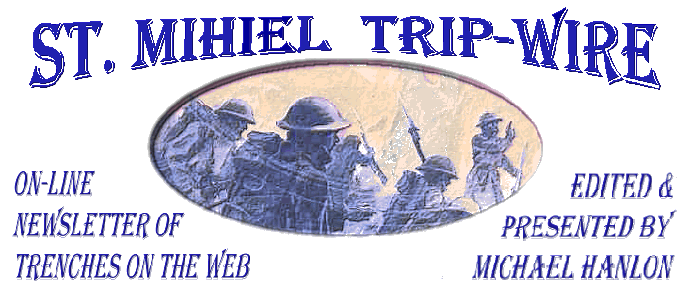
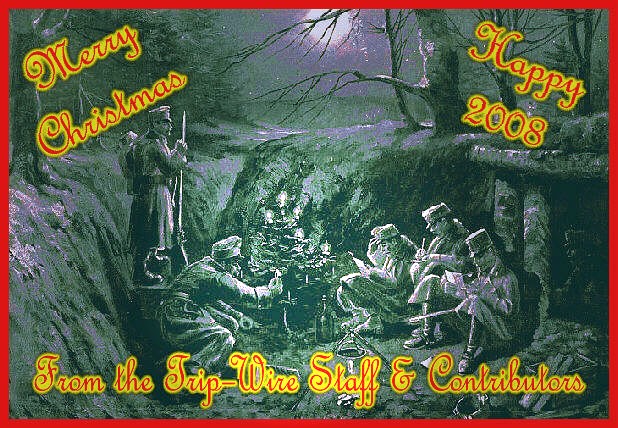
TRENCH REPORT: As you can tell from the appearance of our WWI Christmas card, this is our special annual holiday issue. We have also included below some suggestions for Christmas gifts for that WWI enthusiast in your life. You will see the best book I can possibly recommend in "Behind the Literary Lines" and the best new DVD our film reviewer, Andrew Melomet, can recommend in "Andy's Nickelodeon". One last suggestion. You probably know that for the past year, we have also been publishing a subscription magazine on the Great War called OVER THE TOP. We are making the first year's twelve issues available on CD with some extras added: slide-shows of 100 notable veterans of the war and 50 memorable sites on the Western Front, plus a WWI Hit Parade of musical files you can play on your computer or iPod. You will see an icon below on the left, if you would like ordering information for or CD. MH
This Month's Internet Feature
War In the Pacific
Capture of German Samoa, 1914
Siege of Tsing Tao
Australia's Mightiest Man-of-War: HMAS Australia
Admiral Maximilian von Spee
Australian Naval and Military Expeditionary Force
Imperial Japanese Navy in WWI

French Machine Gun Crews
Verdun, France
New at Our Own & Our Friends' Great War Websites
Click on Title or Icon to Access
|
A New Site of Considerable Merit
Great War Dust Jackets
At Great War Society Sites
The Great War Society Announces
 |
At the WFA-USA
|
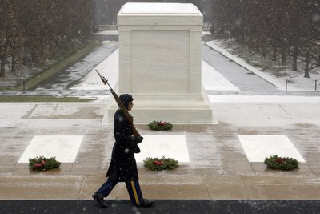
Tomb of the Unknowns in Winter

On the Thiepval Memorial to the Missing at the Somme Battlefield you will find the name of Pvt. Percy Jeeves of the Royal Warwickshire Regiment. He was the onetime cricket great who inspired the name for P.G. Wodehouse's character, Jeeves. Cricket fan Wodehouse had seen Jeeves play before Wodehouse's departure for America. Jeeves the manservant appeared in the Saturday Evening Post shortly after Jeeves the cricketer/soldier, perished in the Battle of the Somme.
|
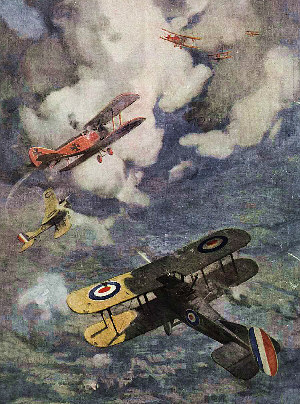
British-German Air Battle from British Magazine
Sphere, October 1918
GREAT WAR 2008 EVENT CALENDAR
|
Great War Society National Seminar
South San Francisco, CA
The War at Sea & In the Air
April 11-13 2008
(information)
|
WFA-USA National Seminar
Carlisle Barracks, PA
America's Great War -
America's Great Warriors
September 12-14 2008
(information)
|
Western Front Association
U.S. Branch Chapter Meetings
Check for Your Region
Regularly Updated (details)
|
Great War Society Monthly Chapter Meetings
Berkeley, San Francisco and Palo Alto, CA
Regularly Updated (details)
|
Send additions/corrections:
Email Response
|

Memorable Event
|
Russo-German Armistice
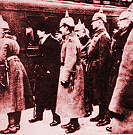
Russia Leaves the War
December 16, 1917
Click on Image To Learn More
|
|
A Reminder from a Reader: The Library of Congress website now includes the full collection of the Doughboys' newspaper Stars and Stripes. The viewer is a bit ponderous to use, but once you get the knack, it's fairly easy to move around the pages. (link)
The Smithsonian American Art Museum has an exhibit of Forty-five WWI posters through February 3rd, titled Over the Top: American Posters from World War I
The British Postal Museum has produced some fascinating and eye-catching educational materials for young persons, including a beautifully done WWI timeline. These can be downloaded at: (pdf files)

[It's] another of those pesky half-holidays, with some things open, other things closed and everybody confused and/or uninterested. Now it's called Veterans Day, but when Nov. 11 was Armistice Day, it had meaning and poignancy - parades at slow time, muffled drums, black armbands, gold star flags in front windows of grieving mothers. The Civil War was a horror, but World War I was the real thing, dragging this coltish young nation into the international arena. It was all so innocent that those of our generation cannot hear "My Buddy" or "Over There" without a lump in the throat. I won't say "Happy Veterans Day" because the phrase makes no sense. From San Francisco Columnist Herb Caen,
Nov. 9, 1986
|
|
American Volunteers Memorial, Place États-Unis, Paris Photo by Gary Van Loon
|

|
|
|
Page Two
|
|
|
Who Is This Notable Figure from World War I?
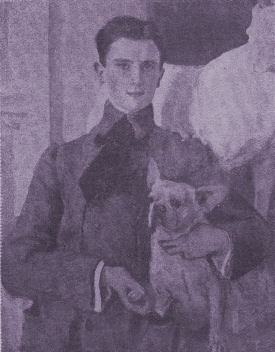 |
The delicate looking gentlemen on the left is Prince Felix Yusupov, who with Grand Duke Dmitri Pavlovich, was one of the assassins of Rasputin. Never prosecuted for the poisoning, shooting and drowning of the monk, he managed to escape the Reds at the end of the war. Eventually landing in Paris, he continued the dissolute life he had begun as a boy at court. According to some sources, he gained some repute as the the city's most beautiful transvestite. [Sorry, we tried hard but couldn't find a photo of Felix in drag.] He did testify under oath about Rasputin's killing, however, in a trial in which he and his wife successfully sued MGM Studios for invasion of privacy in their 1932 film Rasputin and the Empress. His interesting testimony is reported in the archives of Time magazine. (link) Yusupov outlived his victim a half century, dying in 1967. |
|
|

|
Sleeping Beauty #4
on the Western Front
The Trenches of Bois Brulé
By Christina Holstein
|
In some areas of the St. Mihiel Salient, the French and German front lines are really close together. One such area is Bois Brulé, which is an extensive area of woodland above the little town of Apremont east of the town of St. Mihiel. Recaptured by the French Colonial Corps during the Franco-American St. Mihiel Salient operation in September 1918, Bois Brulé had seen brief action by the U.S. 26th Division in April of that year. The first Distinguished Service Cross awarded to a member of the AEF was for an action in Bois Brulé at this time.
For four years the French and German front lines in Bois Brulé were only a few metres apart. The lines have recently been cleared and restored, and although the French forward trench is not a true representation of the line as it existed in 1918, it is interesting as an example of French trench-building techniques used earlier in the war.
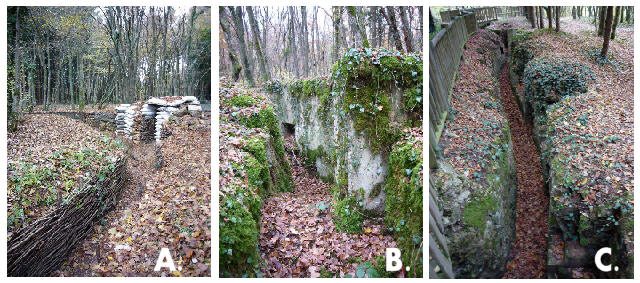
A. Reconstructed French Front Line in Bois Brulé B. Buttressed Second Line With Ammunition Niches
C. Part of Nearby German Front Line
Much more interesting than the cleared front lines, however, is the German second line which, only a few metres farther back, is overlooked, overgrown and forgotten. It snakes north for several kilometres, and the visitor who pushes through the undergrowth can still find well-preserved concreted trenches equipped with firesteps, niches for rifle ammunition and hand grenades, observation posts and entrances to underground dug-outs.
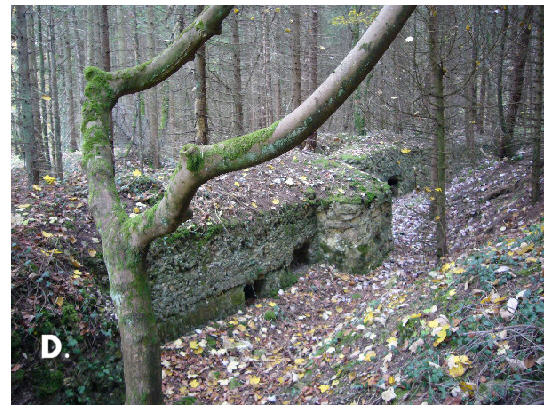
D. German Second Line in Bois Brulé
|

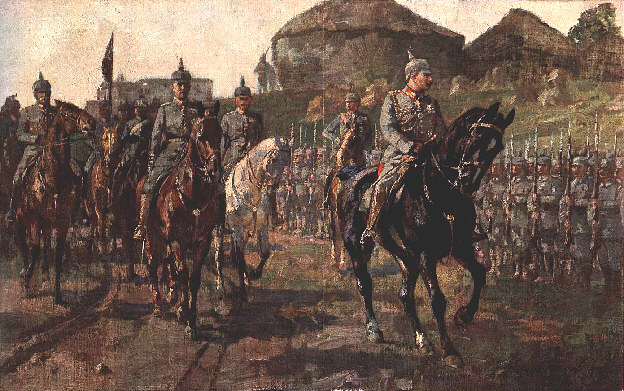
Kaiser Wilhelm with Ludendorff Reviewing Troops on the Eastern Front
Click Here to Visit War in a Different Light
|
| Eyewitness: Recollecting Ypres
|
The city of Ypres was the capital of our battlefields in Flanders from the beginning to the end of the war, and the ground on which it stands, whether a new city rises there or its remnants of ruin stay as a memorial of dreadful things, will be forever haunted by the spirit of those men of ours who passed through its gates to fight in the fields beyond or to fall within its ramparts.
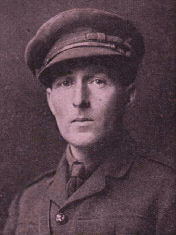
Sir Philip Gibbs |
I went through Ypres so many times in early days and late days of the war that I think I could find my way about it blindfold, even now. I saw it first in March of 1915, before the battle when the Germans first used poison-gas and bombarded its choking people, and French and British soldiers, until the city fell into a chaos of masonry. On that first visit I found it scarred by shellfire, and its great Cloth Hall was roofless and licked out by the flame of burning timbers, but most of the buildings were still standing and the shops were busy with customers in khaki, and in the Grande Place were many small booths served by the women and girls who sold picture post-cards and Flemish lace and fancy cakes and soap to British soldiers sauntering about without a thought of what might happen here in this city, so close to the enemy's lines, so close to his guns. I had tea in a bun-shop, crowded with young officers, who were served by two Flemish girls, buxom, smiling, glad of all the English money they were making.
A few weeks later the devil came to Ypres. The first sign of his work was when a mass of French soldiers and colored troops, and English, Irish, Scottish, and Canadian soldiers came staggering through the Lille and Menin gates with panic in their look, and some foul spell upon them. They were gasping for breath, vomiting, falling into unconsciousness, and, as they lay, their lungs were struggling desperately against some stifling thing. A whitish cloud crept up to the gates of Ypres, with a sweet smell of violets, and women and girls smelled it and then gasped and lurched as they ran and fell. It was after that when shells came in hurricane flights over Ypres, smashing the houses and setting them on fire, until they toppled and fell inside themselves. Hundreds of civilians hid in their cellars, and many were buried there. Others crawled into a big drain-pipe--there were wounded women and children among them, and a young French interpreter, the Baron de Rosen, who tried to help them--and they stayed there three days and nights, in their vomit and excrement and blood, until the bombardment ceased. Ypres was a city of ruin, with a red fire in its heart where the Cloth Hall and cathedral smoldered below their broken arches and high ribs of masonry that had been their buttresses and towers.
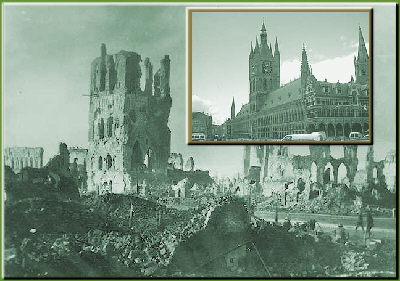
Ypres Cloth Hall: Then and Now
When I went there two months later I saw Ypres as it stood through the years of the war that followed, changing only in the disintegration of its ruin as broken walls became more broken and fallen houses were raked into smaller fragments by new bombardments, for there was never a day for years in which Ypres was not shelled.
War Correspondent Sir Philip Gibbs
Now It Can Be Told, 1920
|
|

|
1917 on The Western Front
By Tony Noyes
December
Winter Comes to the Western Front
|
In December, 1917 simply petered out with the German troops still in overall control of the Western Front battlefields, having given up little ground.
For over four hundred miles from the sand-blown wastes of the coast at Nieuport, through the sordid mud of the Ypres Salient, the chalk of Vimy Ridge, the abattoir of the Somme and into the Noyon Salient; through the devastation of Champagne and the shattered-trees of the Argonne Forest; through the bone yard of Verdun, past the concrete stronghold of the St. Mihiel Salient, beyond Pont-a-Mousson and south to the high ground of the Vosges mountains and thus to the Swiss border, the armies tried to make their miserable daily life as comfortable as possible as winter approached -- and to stay alive.
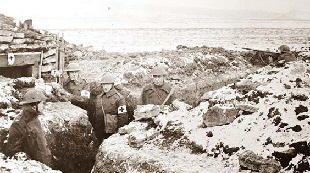
Early American Arrivals Spending the
1917-18 Winter in the Trenches
|
In Italy the eleven battles on the Isonzo river had culminated with a twelfth struggle to become known as Caporetto. Italian and Austrian casualties in three years totaled 900,000 men. The Russian Revolution and the ensuing peace agreements in that unhappy country meant that the Germans could free up some 80+ divisions for the Western Front for the next year. They were to arrive and go into action in March and April 1918, and these epic battles will be written of in future Trip-Wires.
Hope for a successful end to this unending war within the British and French forces faded with the end of 1917. In Germany, unrest was stirring within the population and the British naval blockade was biting hard, affecting everyday life in the German Empire.
America had come into the war in April, but the willingness of the President could not be matched quickly by the efforts of the U.S. industry and military. Most of 1917 was taken up in organising for the producing and equipping of eighty 28,000-man divisions, as envisaged by John J. Pershing, Commander of the American Armies in France. The world waited for the Americans with hope or with fear.
|
|
|
Subscribe to Our New On-Line Magazine
|
|

|
|
|
Page Three
|
| Celebrating Armistice/Remembrance/Veterans Day
|
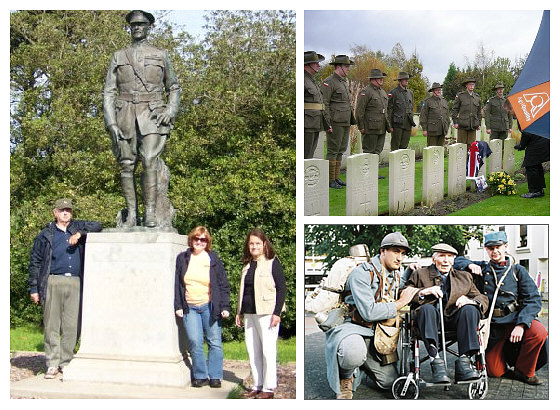
The great holiday of the Great War was celebrated in different ways in 2007. On the left above, your editor is shown at the General Pershing statue in San Francisco's Golden Gate Park with WFA-USA officers Susan Hall-Balduff, Editor of the Association's Journal Camaraderie, (she's the redhead), and Susan Neeson, Chair of the West Coast Chapter (the brunette). WFA-USA Director Richard Vandenbrul was behind the camera. This was one stop in my "San Francisco and WWI" tour I give to my fellow enthusiasts. Above right, Digger reenactors honor the fallen at Harlebeke New British Cemetery in Flanders. Below, two French reenactors in Paris visit with 109-year-old veteran of the French and Italian armies Lazare Ponticelli. Lazare and Louis de Cazenave, 110, are the last two surviving Poilus of the Great War. Both, interestingly, have declined the honor of a state funeral, not wanting to place themselves apart from so many of their compatriots who died without such recognition.
|
 |
Sewell Tyng's The Campaign of the Marne
Reviewed by Editor Mike Hanlon
|
Read This Book!
This is simply the best account of any battle from any war I've ever read. It also has the best and most helpful maps I've encountered. Completed in 1935 by a former ambulance driver from the war, who was also Herbert Hoover's private secretary at the Paris Peace Conference, The Campaign of the Marne, has recently been reissued by U.S. publisher Westholme as a large format quality paperback. This would make a fine Christmas gift for any World War I student or enthusiast.
(Order at Amazon.com)
|
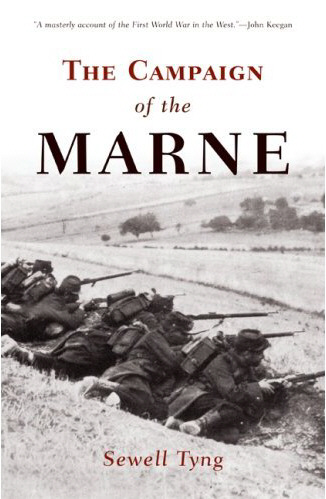
|
|
World War I Headlines
in the
21st Century
|
|
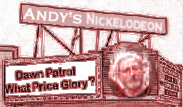 |
The Halifax Explosion on DVD
By Andrew Melomet
|
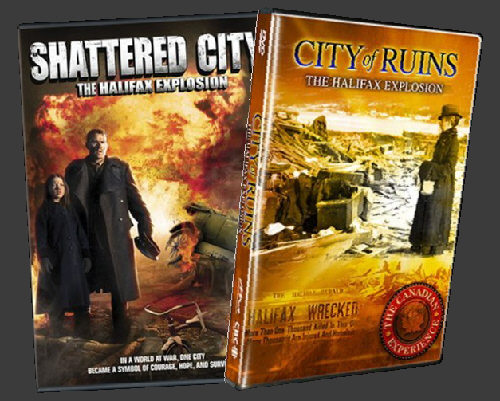
Prior to the development and use of atomic weapons, the greatest man-made (although unintentional) explosion probably occurred on December 6th, 1917, just ninety years ago this month in the City of Halifax, Nova Scotia, Canada. Halifax is the closest mainland port to Europe and was a homeport for the Royal Navy until 1905. After that it served as a port for the Royal Canadian Navy. A large natural harbor and ice-free in winter, its strategic importance was of great value during World War One with convoys being assembled with Allied ships from the eastern seaboard destined for the United Kingdom and war-torn Europe.
On December 6th, 1917, a French cargo ship, the Mont-Blanc, carrying wet and dry picric acid, gun cotton, TNT and drums of benzol collided with the Imo, a Belgian relief ship in "The Narrows" shipping channel in the port of Halifax. After the collision, the Mont-Blanc drifted close to shore. The fire caused by the collision and the exploding barrels of benzol shooting into the air drew fire fighters and a crowd of onlookers down to the docks. Other curious inhabitants watched from roofs and windows.
Shortly after 9 AM, the Mont-Blanc exploded with the force of approximately 3 kilotons of TNT, the equivalent of a tactical nuclear weapon. The force of the blast caused a tsunami that swept over the crowd and carried their bodies into the water. The blast effect destroyed buildings, toppled chimneys, blew in doors and shattered windows throughout the city. Ships were tossed on shore. Trees were snapped. The anchor shaft of the Mont-Blanc was hurled 2 ¾ miles crashing to ground on a farm on the outskirts of the city. The blast was heard in North Cape Breton, 225 miles to the east.
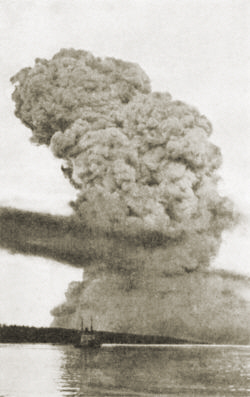
Halifax Harbor
6 December 1917 |
The fires started by overturned ovens and furnaces were fueled by stockpiled winter fuel supplies. Many initial survivors trapped in the rubble were burned to death. The following day a blizzard buried the city in snow. Victims still trapped were buried by the snowstorm. The last of the survivors were found six days after the initial explosion. Corpses were discovered for nearly a year afterwards. The approximate casualty estimate is 2,000 killed and 9,000 wounded and blinded. More Nova Scotians died in the Halifax explosion than were killed in World War One. Out of 60,000 inhabitants, 25,000 were left homeless. So many people suffered eye injuries that the science of treating damaged eyes was advanced significantly by the newly established Canadian National Institute for the Blind. Halifax would become known as a center for caring for the blind.
Relief efforts started almost immediately from nearby towns. Medical personnel from ships in the harbor came ashore. Even before the total magnitude of the disaster was known, relief was on the way from the rest of Canada and from the United States. The first American medical relief train from Massachusetts arrived on December 8th. The first relief ship from the rival port of Boston arrived in Halifax on December 12th with clothing, food, window glass and other materials. Trained glaziers came to install the new panes. A second American ship with a valuable cargo of ten trucks arrived on the 13th. Eventually aid was received from all over Canada, the United States and from the United Kingdom. Even Australia and New Zealand sent contributions. Since 1971 the Province of Nova Scotia has sent an annual Christmas tree to the city of Boston as a symbol of appreciation for the relief received from Massachusetts.
In 2003 the Canadian Broadcasting Corporation produced two programs covering the Halifax Explosion. Both are available on DVD from Morningstar Entertainment in Canada, which is where I obtained my copies. Shattered City: The Halifax Explosion is available from RHI Entertainment in the United States. City of Ruins: The Halifax Explosion is a well-done forty-five-minute documentary directed by Alan Mendelsohn and written and produced by Sally Reardon and Mendelsohn. It incorporates archival newsreel footage and photographs and special effects footage from Shattered City: The Halifax Explosion mini-series. City of Ruins also includes two CBC-TV featurettes. Explosion Sites Today has Jim Simpson leading a walking tour of Halifax harbor, discussing the tragedy and pointing out the still-existing material evidence of the explosion. The 2nd featurette, Explosion Survivors is an emotional July 2003 visit of childhood survivors to Halifax. They tell the same stories as they have over the decades to so many, and still the trauma of the events rises to the surface.
Shattered City: The Halifax Explosion is less successful in its depiction of the disaster and its aftermath due to the historical distortions and inaccuracies it contains. Produced by Heather Haldane and Jenipher Ritchie, written by Keith Ross Leckie and directed by Bruce Pittman, Shattered City has excellent production values. The special effects and CGI sequences are very well done and much better looking than the CGI in the Above And Beyond mini-series (see review in the April 2007 issue of The St. Mihiel Trip-Wire). The historical settings, production design and costumes all seem appropriate to the period.

Aftermath I
The story line follows members of a fictitious Halifax family, the Collins, and their experiences before, during, and after the disaster. The acting is overall of the high quality I've come to associate with modern Canadian productions. Vincent Walsh as war-weary Captain Charlie Collins gives an excellent portrayal of a man who has seen too much of war and finds his home town leave turned into an experience as terrible as anything he has experienced on the Western Front. Shauna MacDonald, better known to Canadian audiences for her ensemble television comedy work, is Boston doctor Barbara Paxton who manages to fall in love with Captain Collins amidst the ruins of Halifax. One of the advantages of watching a CBC-TV production is being introduced to unfamiliar actors who give excellent performances. Two familiar faces are Graham Greene as Elijah Cobb, who gives important testimony in the criminal manslaughter trial and Pete Postlethwaite as attorney Charles Burchell.
Unfortunately, the script has some major errors. First, it has a German spy ring planning sabotage on the Mont-Blanc with prior knowledge of its arrival in Halifax. There were no German spies in Halifax. Second, it presents a post-disaster criminal manslaughter trial riddled with conspiracy and government intervention. This trial appears to be based on a Naval Inquiry, an actual criminal manslaughter trial, and a civil court case that all occurred at different times. Even the outcome of the depicted trial is at variance with actual events and accused parties! Last, the mini-series depicts Halifax as without surgeons and with only two makeshift hospitals until the surgeons and medical personnel arrive from America. Actually, there were a half-dozen local hospitals functioning in addition to nearby military medical facilities.
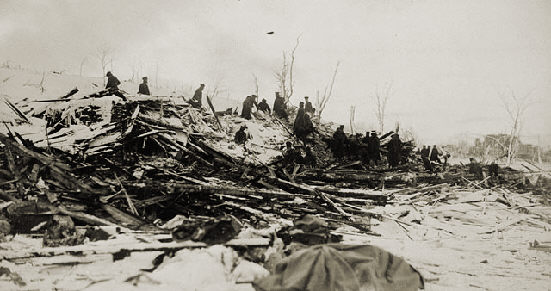
Aftermath II
The Shattered City: The Halifax Explosion DVD is widescreen but not enhanced for widescreen televisions. If your DVD player or TV has a zoom function you'll need to use it to fill a 16 x 9 set. The Dolby Digital Stereo was well produced and did the job of conveying all the explosion effects. Special features include Cast and Production Biographies, a Behind the Scenes Photo Gallery, Special Effects Scenes, Behind the Scenes featurette, an Interview with Executive Producer Mary Young Leckie, a Glamorous Life of a Film Extra featurette and a CBC-TV News featurette on Explosion Survivors.
I can certainly recommend the documentary City of Ruins: The Halifax Explosion as a worthwhile addition to your library of World War One documentaries. The mini-series Shattered City: The Halifax Explosion was certainly well produced, well acted and entertaining, but any viewer should be aware of its historical inaccuracies and distortions prior to watching.

Still from Wooden Crosses |
As part of our Christmas special edition, I've been asked to recommend a new WWI DVD suitable as a holiday gift. I suggest Raymond Bernardís outstanding 1932 film Wooden Crosses, considered the French equivalent to All Quiet On the Western Front, which was issued in July by Eclipse films -- a subsidiary of Criterion. It comes in a set with Bernard's Les Miserables, considered by some experts to be the finest film dramatization of Victor Hugo's great novel. Click here to order this excellent set (link). A.M.
Andrew Melomet, Proprietor of Andy's Nickelodeon, will answer your Great War film or video inquiry. He wants your recommendations for the WWI Filmography he is compiling for our readers. Just click HERE.
|
|
| | |






























